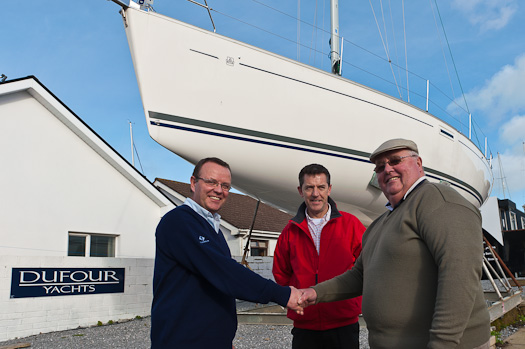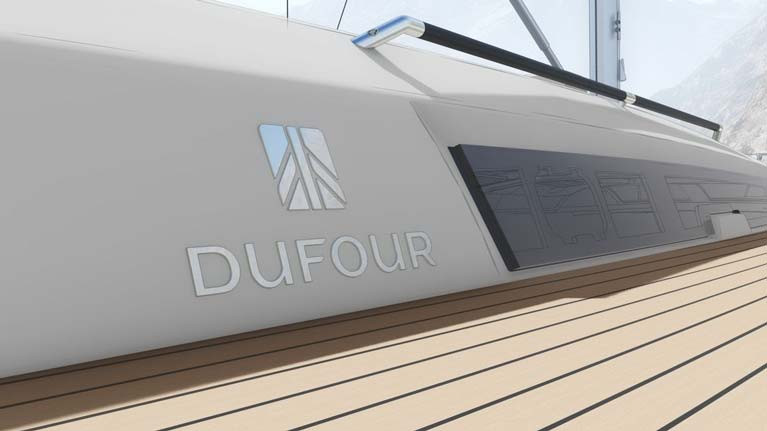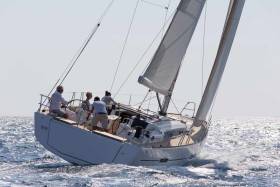Displaying items by tag: Dufour
Dufour 530 To Be Unveiled at BootDüsseldorf This Saturday
The Dufour 530 will be unveiled at Boot Düsseldorf this Saturday 18th January, at the opening of the show.
Designed by the Italian architect Umberto Felci, the Dufour 530 is available in three versions and three new models.
Hugh Mockler of Irish agents Crosshaven Boatyard is happy to welcome clients on the stand to visit this boat and plus four other iconic models, including two new 2019 models.
The French brand is offering Düsseldorf Special Offers* on the following models to get the year off to a good start: Dufour 360, Dufour 430, Dufour 460 and Dufour 56.
More details here
Dufour Irish Agent Crosshaven Boatyard Prepares for Paris & Dusselfdorf Boat Shows
Five Dufour yacht models will be on display at next month's Paris Boat Show (7-15 December). the best-seller Dufour 360, the two new models from 2019, Dufour 390 & Dufour 430, the iconic Dufour 460 and the flagship, the Dufour 56.
Irish agents Crosshaven Boatyard in Cork Harbour say they are delighted with the superb models coming out of the Dufour Yachts Factory in La Rochelle. "These performance cruising yachts designed by Italian Felci Yacht Design Group combine speed, ease of handling and Dufour Yachts quality," Crosshaven's Hugh Mockler told Afloat.
As Afloat reported previously, Boot Düsseldorf will also be an important event with the unveiling of the Dufour 530, the new model is available in three versions and the Ocean Version will be displayed.
Four other boats will be on display: Dufour 360, 390, 430 and 460 at Boot.
If you are planning to go to either Paris or Dusseldorf Boat Shows, please drop an email to [email protected] to arrange viewings.
Cork’s Charms On Display At Southampton Boat Show
#MarineTrade - Cork Harbour is ably represented at the Southampton Boat Show this week.
The Port of Cork has teamed up with the Royal Cork Yacht Club and Bantry Bay Port Company to promote the Rebel County’s marinas and cruising opportunities.
Their joint stand under the banner ‘Destination County Cork’ can be found at stand J047.
Joining with @royalcork and #Bantry Bay Port Company to promote our marinas at the @SotonBoatShow #Cork #Crosshaven and #west cork are all super cruising grounds for exploring and enjoying #WeAreCork #PureCork pic.twitter.com/VSAGQHnsjf
— Port of Cork (@PortofCork) September 20, 2018
Meanwhile, Crosshaven Boatyard is in attendance displaying its latest range of Dufour Yachts at stands M310, M312, M316 and M318.
We are also at @SotonBoatShow displaying our @_DufourYachts_ range ⛵️?? pic.twitter.com/PmF59LTvwP
— Crosshaven Boatyard (@CrosshavenBY) September 20, 2018
The 2018 Southampton Boat Show continues till this Sunday 23 September.
Crosshaven Boatyard Report Promising Brokerage Enquiry Levels for 2014
#cby – Brokerage sales for Cork harbour yacht broker Crosshaven Boatyard (CBY) in 2013 was steady with some boats going abroad but thankfully the majority staying in Ireland.
Recent boat sales for CBY include a 2006 Jeanneau Merry Fisher 925, 1998 Jeanneau Sun Odyssey 34.2, 1983 Beneteau First 30e and a 1984 Gib'Sea 76.
'Enquiry levels have been promising in the last few weeks' says CBY's Hugh Mockler who is looking forward to increasing sales in 2014.
'We are in a fortunate situation in that as soon as we sell a few boats on brokerage new additions appear i.e. we have just added an excellent 2005 Jeanneau Sun Odyssey 49 DS to our brokerage and we also have a 1975 Dufour 35 and a 1979 Rival 38 coming shortly,' he adds.
CBY is actively promoting new yacht sales too. The brand new Dufour 310 Grand Large which was launched at Paris Boat Show and the new Dufour 560 Grand Large to be launched in Istanbul next Month are also on their books.
Further Price Reduction on 2006 Dufour 385
#BOATS FOR SALE – A 'lightly used' Dufour 385 built in 2006 has been further reduced by €15,500 and is now available at €99,000. The family cruiser is described online as 'solid and well equipped'. The yacht, which can be seen at Crosshaven boatyard, Cork comes with an upgraded engine (40HP Volvo). The yacht has twin wheels and an In-mast furling mainsail. The full advert giving detailed specs is on the Afloat Boats for Sale site.
Nice 32-Foot Family Sailing Cruiser for €54,950
Hugh Mockler Joins Crosshaven Boatyard
Crosshaven Boatyard Company Ltd has announced that Hugh Mockler, (formerly of HM Yachts Ltd), is to join long established yacht broker, Donal McClement in the Boatyard's new boat and brokerage sales division.
Matt Foley, General Manager of Crosshaven Boatyard, told Afloat, 'Donal and Hugh are two of the best known and most successful Yacht Brokers in Ireland. Over the past number of years and their combined knowledge of a very difficult market will ensure that the buyers and sellers get a top class service'. Hugh and Donal will be able to give buyers and sellers the best possible advice.'
Crosshaven Boatyard has been providing marine services for over 60 years.
The boatyard also specialises in all aspects of the repair and maintenance of modern pleasure boats. Many well-known boats such as Gypsy Moth V, the Saint Brendan, Longbow II and a series of Moondusters were completed in the1980s.
It was the first commercial marina, with a marine travel hoist, in Ireland in 1979. The yard is the Irish distributor for Dufour Yachts of France, and Grand Soleil, of Italy.

Hugh Mockler (left) is greeted by General Manager Matt Foley (centre) and yacht broker Donal McClement. Photo: Bob Bateman



































































